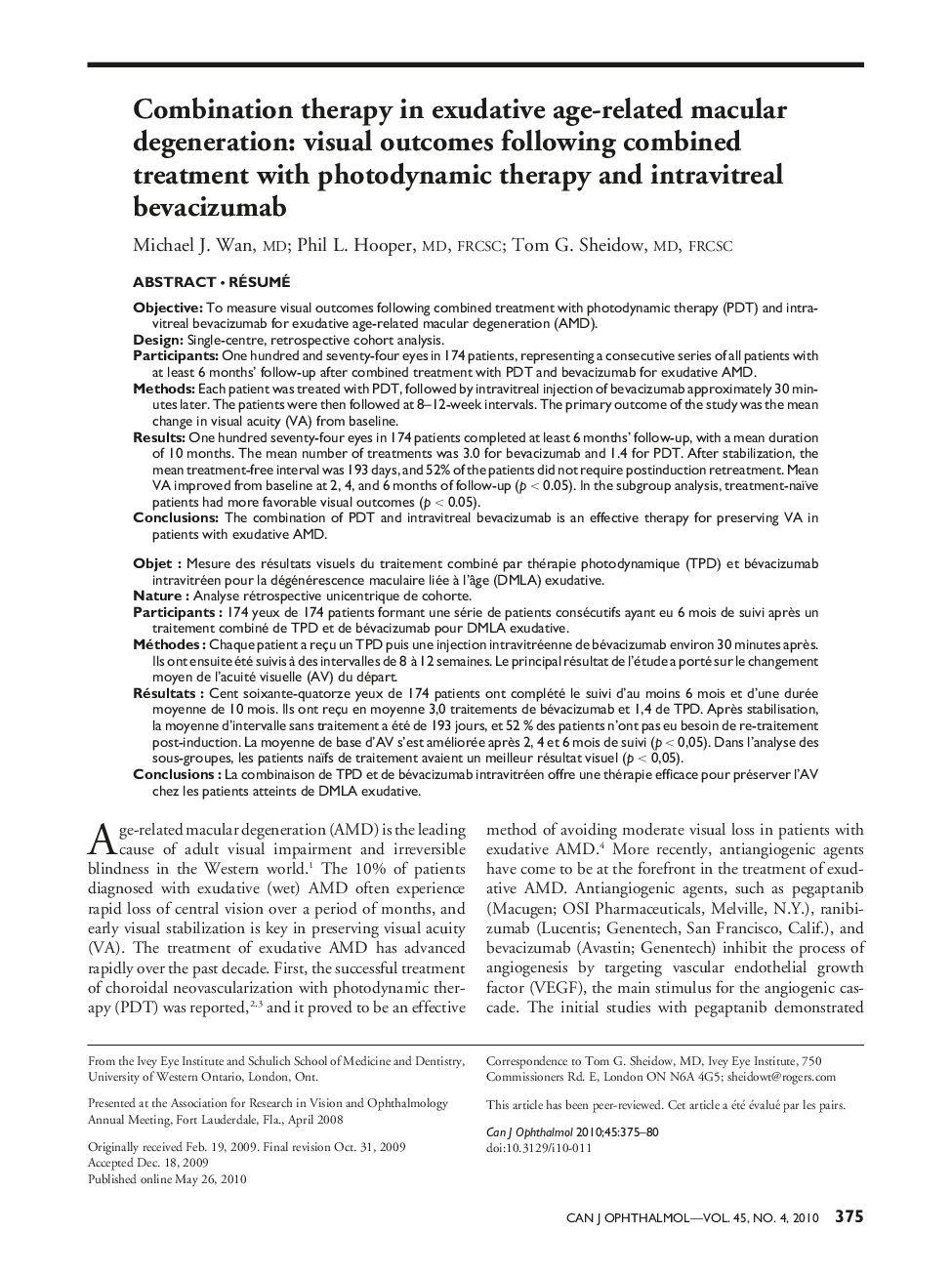| Article ID | Journal | Published Year | Pages | File Type |
|---|---|---|---|---|
| 4010254 | Canadian Journal of Ophthalmology / Journal Canadien d'Ophtalmologie | 2010 | 6 Pages |
Objective: To measure visual outcomes following combined treatment with photodynamic therapy (PDT) and intra-vitreal bevacizumab for exudative age-related macular degeneration (AMD).Design: Single-centre, retrospective cohort analysis.Participants: One hundred and seventy-four eyes in 174 patients, representing a consecutive series of all patients with at least 6 months’ follow-up after combined treatment with PDT and bevacizumab for exudative AMD.Methods: Each patient was treated with PDT, followed by intravitreal injection of bevacizumab approximately 30 minutes later. The patients were then followed at 8–12-week intervals. The primary outcome of the study was the mean change in visual acuity (VA) from baseline.Results: One hundred seventy-four eyes in 174 patients completed at least 6 months’ follow-up, with a mean duration of 10 months. The mean number of treatments was 3.0 for bevacizumab and 1.4 for PDT. After stabilization, the mean treatment-free interval was 193 days, and 52% of the patients did not require postinduction retreatment. Mean VA improved from baseline at 2,4, and 6 months of follow-up (p < 0.05). In the subgroup analysis, treatment-naïve patients had more favorable visual outcomes (p < 0.05).Conclusions: The combination of PDT and intravitreal bevacizumab is an effective therapy for preserving VA in patients with exudative AMD.
RésuméObjet: Mesure des résultats visuels du traitement combiné par thérapie photodynamique (TPD) et bévacizumab intravitréen pour la dégénérescence maculaire liée à l’âge (DMLA) exudative.Nature: Analyse rétrospective unicentrique de cohorte.Participants: 174 yeux de 174 patients formant une série de patients consécutifs ayant eu 6 mois de suivi après un traitement combiné de TPD et de bévacizumab pour DMLA exudative.Méthodes: Chaque patient a reçu un TPD puis une injection intravitréenne de bevacizumab environ 30 minutes après. Ils ont ensuite été suivis à des intervalles de 8 à 12 semaines. Le principal résultat de l’étudea porté sur le changement moyen de l’acuiteé visuelle (AV) du deépart.Résultats: Cent soixante-quatorze yeux de 174 patients ont complété le suivi d’au moins 6 mois et d’une durée moyenne de 10 mois. Ils ont recu en moyenne 3,0 traitements de bévacizumab et 1,4 de TPD. Après stabilisation, la moyenne d’intervalle sans traitement a été de 193 jours, et 52 % des patients n’ont pas eu besoin de re-traitement post-induction. La moyenne de base d’AV s’est ameliorée après 2,4 et 6 mois de suivi (p < 0,05). Dans l’analyse des sous-groupes, les patients naïfs de traitement avaient un meilleur résultat visuel (p < 0,05).Conclusions: La combinaison de TPD et de bévacizumab intravitreéen offre une thérapie efficace pour preéserver l’AV chez les patients atteints de DMLA exudative.
